Content
- How to distinguish chronic rhinitis from other diseases, characteristic symptoms
- Forms of chronic rhinitis and effective groups of drugs for their treatment
- Catarrhal
- Hypertrophic
- Atrophic
- Vasomotor
- Professional
- Allergic
- Infectious
- Medicines for rhinitis
- Vasoconstrictor
- Moisturizers and emollients
- Antihistamines
- Antiseptic
- Antibacterial
- Immunomodulatory
- The most effective therapeutic regimens for chronic rhinitis in adults
- Atrophic and subatrophic
- Catarrhal
- Hypertrophic (hyperplastic)
- Vasomotor
- Allergic
- What is the danger of a lingering rhinitis, the consequences in the absence of treatment
- Rhinitis video
More and more cases are registered in the world every year chronic rhinitis in an adult population. Experts associate this with the deterioration of the environmental situation, a decrease in the number of doctors seeking help, an aggressive advertising campaign for drugs with a quick, but not long-term effect, as well as their availability in pharmacy chain. All this leads to inadequate uncontrolled self-medication and chronicity of acute rhinitis.
How to distinguish chronic rhinitis from other diseases, characteristic symptoms
The manifestations of chronic rhinitis (XP) are diverse due to the fact that it combines a whole group of polymorphic diseases, different in origin, but having some basic similarities, which allow them to be connected into a single, more global concept.
XP should first of all be distinguished from acute: take into account the history of the disease. The nature of the course is most often persistent (protracted, continuous), and the duration of the disease is more than 1 month. Characterized by the presence of signs of infectious or traumatic inflammation, which are usually acute.
One of the most common pathologies with which chronic rhinitis has to be distinguished is chronic sinusitis, in which there is:
- increased body temperature (may be insignificant);
- frequent attachment of other bacterial and viral infections of the upper respiratory tract;
- visible swelling of the face;
- painful sensations in the places of projection of the paranasal sinuses;
- an increase in the volume of discharge from one or both halves of the nose with certain changes in body position.
X-ray of the paranasal sinuses or their computed tomography is considered the "gold standard" for diagnosing sinusitis, if the clinic has the necessary equipment and specialists.
For a specialist, the greatest interest in diagnostic search is the differentiation of different forms of the disease each other to determine the optimal treatment strategy and increase the accuracy of statistical accounting diseases.
Forms of chronic rhinitis and effective groups of drugs for their treatment
Chronic rhinitis (treatment in adult patients directly depends on the form and nature of the origin of the pathology) responds well to symptomatic therapy.
In the clinical classification according to I.B.Soldatov in 1990, which was recognized as the reference among ENT doctors, only 4 forms of HR were identified, which, in turn, are still subdivided into subtypes.
Catarrhal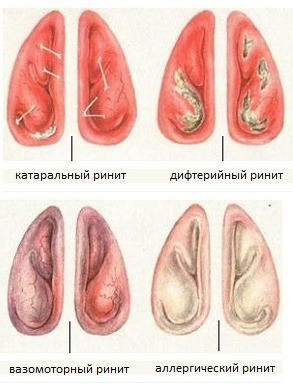
Catarrhal (or simple) rhinitis is a condition that most often develops as a result of a long course (or repeating through short period of time) acute rhinitis, for complaints which are characterized by the presence of difficulty in nasal breathing due to moderate or abundant mucous (less often watery) discharge, decreased olfactory ability and increased nasal congestion in the horizontal position.
A simple test with the instillation of a 0.1% naphthyzine solution will help to distinguish this form from the hypertrophic one. the concentration at which, in the case of catarrhal rhinitis, the swelling of the nasal mucosa completely disappears.
Chronic rhinitis (catarrhal treatment in adults is usually straightforward) is treated with a protracted acute rhinitis therapy of appropriate quality and duration, including:
- obligatory regular washing of the nasal cavity with water-salt solutions;
- nasal decongestants on demand (usually before bedtime is warranted);
- antibacterial, antiviral agents locally or internally as prescribed by the attending physician (if necessary).
Hypertrophic
The hypertrophic form usually develops as a result of prolonged adverse effects of cold, wet air, smoke, and other gases, may be due to untreated catarrhal rhinitis, sinusitis, or adenoiditis.
A distinctive feature is the proliferation of connective tissue on the middle and lower nasal shells, which prevents the ability to adequately affect the mucous membrane of the nasal decongestants. Due to the constant and pronounced nasal congestion, the patient's well-being quickly deteriorates, he feels heaviness and aching monotonous headache, sense of smell disappears, the voice becomes nasal and appears snore.
The subtypes of localized and advanced rhinitis differ in the area of the nasal mucosa involved in the inflammatory process.
Effective conservative treatment consists of injections of glucocorticosteroids and immunomodulatory preparations directly into the nasal concha or cauterization of the membranes with chemical compounds of silver and others. In the absence of a sufficient therapeutic effect, the possibility of surgical intervention is considered.
Atrophic
Atrophic rhinitis is characterized by dryness in the nose and throat, accompanied by frequent bleeding, a burning sensation and the formation of yellow or green crusts in the nose with an unpleasant odor. The reasons for the appearance of this form of HR repeat the previous ones: frequent protracted infections of the upper respiratory tract, prolonged contact of mucous membranes with irritating substances, unsuitable climatic conditions, bad habits and unsuccessful surgical intranasal manipulation.
The subtypes are simple (local or common) and fetid coryza (ozena).
Since it is almost impossible to influence the atrophy process, there remains only symptomatic treatment to alleviate the condition: washing nasal cavity with a saline solution of 0.9% concentration with the addition of a small amount of iodine, sterilized by sea water, irritating the mucous membrane lubrication with a solution of iodine-glycerol 0.5% concentration and the use of ointments and oils that soften the crusts and reducing dryness.
Vasomotor
The division into types occurs according to the principle of origin: allergic and neurovegetative, and they are already further branched into more specific causes.
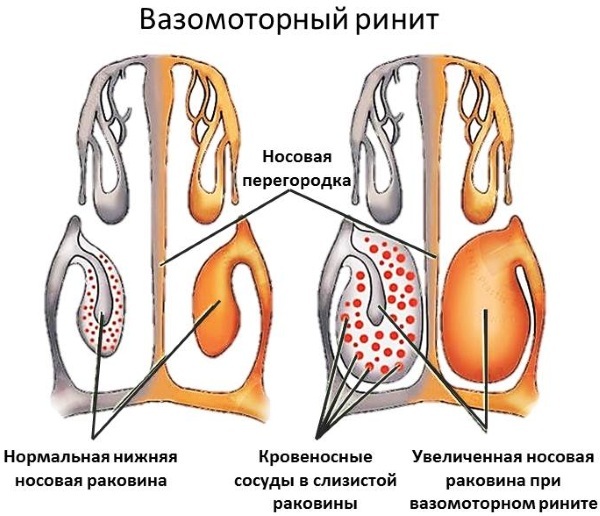
Professional
As an example, consider bakers or flour milling workers, whose mucous membranes, even with barrier devices, are exposed to aggressive contact with small particles of flour, and their defense mechanisms fail rather quickly and allow a painful condition.
Allergic
After contact with a certain type of allergen, the following symptoms appear: itching in the nose, sneezing seizures, profuse watery nasal discharge, gritty sensation in the eyes, their redness and lacrimation.
In the treatment of both professional and allergic rhinitis, the elimination of the causative factor will be decisive, and the following groups are distinguished from the drugs used: antihistamines systemic (tablet forms) and local agents (nasal sprays, drops, ointments and others), injections of glucocorticosteroids and anesthetics into the mucous membrane nose.
Infectious
Infectious rhinitis, with proper treatment and the absence of immunodeficiency, does not have a chronic course, but rather is one of the most likely complications of CP. It is characterized by profuse purulent (with bacterial invasion) or mucous (with viral) discharge, fever, fatigue, headache.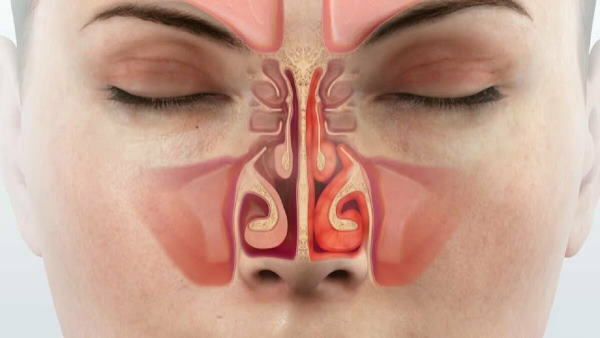
Treatment is aimed at eliminating the infectious agent with antibacterial or antiviral drugs, anti-inflammatory drugs to relieve symptoms of intoxication (temperature and pain), as well as local washing to remove secretions and, if necessary, vasoconstrictor sprays or drops.
Medicines for rhinitis
Chronic rhinitis (treatment in adults should have an integrated approach) requires a change in the patient's lifestyle, prevention of secondary complications, medications of both systemic action and local, physiotherapy procedures and (according to indications) surgical interventions.
Vasoconstrictor
The most diverse category of drugs for the treatment of HR is represented by the following groups of decongestants:
- alpha-1,2-adrenergic receptor stimulants;
- alpha and beta adrenergic agonists;
- adrenaline (epinephrine);
- stimulant of the release of norepinephrine (ephedrine);
- cocaine (inhibitor of norepinephrine utilization).
Characteristics of funds:
-
Phenylephrine (trade names and dosage of 0.125%: Bebifrin, Nazol Baby, Nazol Kids). It is of the greatest importance in pediatric practice, as it gently reduces edema due to gentle vasoconstriction. the nasal mucosa, without reducing blood flow to it, however, due to this, the effectiveness and duration of action suffers drug. The form of release in the form of nasal drops is suitable for use from birth (strictly according to the doctor's prescription), but the spray can be used only after the child reaches the age of six. Adults need 3-4 drops or 2-3 injections of the spray into each nostril, repeat no earlier than 4 hours later. if necessary. Without consulting a specialist, the course of treatment should not exceed 3 days.
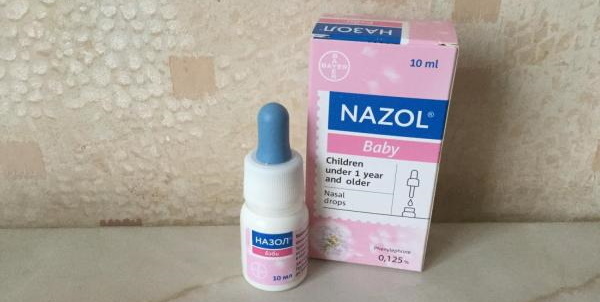
- Xylometazoline (trade names: Xymelin, Otrivin, Rinostop, Snoop and others, dosages 0.05% or 0.1%). It acts for a long time due to the fact that with vasoconstriction, blood circulation in the mucous membrane decreases, which provokes stagnation of the drug in the blood and a slow decrease in its concentration. Available in the form of drops and sprays, in two dosages. Adults 0.1% solution 1 injection into each nostril 2-3 times a day. The course of treatment is not more than 1 week.
- Oxymetazoline (trade names: Nazivin, Nazol, Nazol Advance, dosages 0.025%, 0.05%, 0.1%). He, like xylometazoline, is a long-acting decongestant, but stronger than others affects blood vessels and additionally has its own anti-inflammatory and antioxidant action. It rarely causes an adverse reaction in the form of headache due to cerebral vasospasm, despite its low bioavailability (it is slightly concentrated in the general circulation). Adults should use 1-2 drops of 0.025-0.05% solution or 2-3 injections of 0.05% spray into each nostril 2-3 times a day. The interval between applications should be at least 10-12 hours. The course of treatment is up to 5 days, further use only as directed by a doctor.
- Ephedrine and Epinephrine (adrenaline) are used as an additional component in extremely small doses in the composition combined preparations, or in pure form only for use by medical professionals in medical institutions.
Moisturizers and emollients
For adults suffering from chronic rhinitis, especially atrophic form, in addition to drugs for treatment, it is very important to develop a habit regularly humidify the air of the dwelling, observe an adequate drinking regime and irrigate the nasal mucous membranes as often as possible with water-salt solutions.
Pharmacy preparations of sea water have convenient bottles with special shower nozzles for uniform spraying and minimizing the risk of further injuring the mucous membrane with an excessively strong pressure of liquid, in addition, the contents are usually sterile.
Trade names:
- Aqualor.
- Aquamaris.

Types of the drug Aquamaris spray - Linaqua and others.
It is allowed to use isotonic sodium chloride solution of 0.9% concentration or independently production: completely dissolve 2 g of table salt in 100 ml of cooled freshly boiled water, shelf life 1 day. Auxiliary emollients in ENT practice are ointments and oils.
Among the oils, the most common are peach and apricot oils, they are approved for use in adults without individual allergic reactions to the components of the drug and are contraindicated in bronchial asthma, episodes of broncho- and laryngospasm.
It is necessary to drip 1-2 drops into each nasal passage, being in a horizontal position or throwing your head back, repeat as it dries. Ointments have a thick, viscous consistency and are often less comfortable than oils, because they leave greasy stains on clothes, but they help to retain moisture for a longer time.
Trade names:
- Oxolinic ointment.
- Bactroban (antibacterial action).
- Evamenol (anti-inflammatory, antiseptic effect).
- Pinosol (anti-inflammatory, antiseptic effect).
Apply 0.5 cm of ointment to a cotton swab, distribute it evenly in the nasal cavity, if necessary, press a little on the wings of the nose and massage, repeat up to 4 times a day. The course of treatment is determined individually for each remedy.
Antihistamines
Antihistamines are prescribed for the allergic nature of the common cold, but are sometimes used for other forms.
There are 3 generations of this group of drugs. As newer drugs were developed, they lost their ability to cause drowsiness, and were better absorbed. from the stomach, which contributed to a decrease in the number of doses per day and the fastest development of therapeutic actions.
Some representatives of the 1st generation of drugs:
- Suprsastin;

- Diphenhydramine.
2nd generation:
- Loratadine;
- Claritin.
3rd generation:
- Erius;
- Zodak.
Features of taking drugs:
- Chloropyramine hydrochloride (trade name Suprastin) 25 mg: for adults, 1 tablet by mouth with food, without chewing and drinking half a glass of water 3-4 times a day (75-100 mg / day).
- Diphenhydramine hydrochloride (trade name Diphenhydramine) 50.0 mg: for adults, 1 tablet by mouth with food, without chewing and drinking half a glass of water 1-3 times a day, but not more than 5 tablets / day. The course of admission is 10-14 days.
- Loratadin (trade names: Loratadin, Claritin) 10 mg: for adults by mouth 1 tablet once a day. The course of admission should not be more than two weeks.
- Desloratadine (trade name Erius) 5 mg: orally 1 tablet once a day with 1/2 glass of water, not necessarily with food.
- Cetirizine dihydrochloride (trade name Zodak) 10 mg: orally 1 tablet 1 time per day in the evening (at this time the symptoms are most pronounced), washed down with half a glass of water, not necessarily with food. The course of treatment is 10-14 days.
Antiseptic
The use of nasal antiseptics is justified for local capillary bleeding and for the prevention of bacterial infection.
They are usually produced in the form of sprays:
- Biclotymol 750 mg (trade name Hexasprey): For adults, 2 sprays into each nostril, 3 times a day.
- Hydrogen peroxide 10 mg (trade name Parkon): a solution of 0.25% concentration is sprayed onto the bleeding site until it stops, or 1 injection into each nostril 2-3 times a day. The course of treatment can be long, discussed with your doctor.
Antibacterial
With the infectious nature of rhinitis or with a complication in the form of a bacterial infection, antibacterial drugs are indicated. Based on the general condition of the patient, the severity of the symptoms and the prevalence of the process, the doctor chooses the form of release of the drug that will optimally correspond to the condition of the patient.
These can be tablets or injection solutions that have a systemic effect, with the involvement of structures other than the nose, sprays or drops for local use, and their combination. There are a lot of medicines for oral administration or injections, they are dispensed from the pharmacy strictly according to the doctor's prescription.
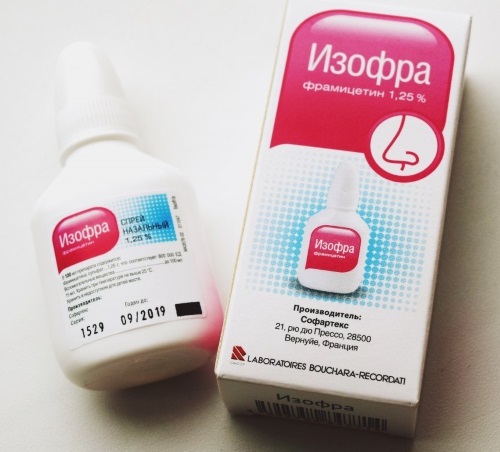
Among the medicinal substances of local action the most widespread are:
- Isofra (active substance from the group of aminoglycosides: framycetin sulfate 1.25 g (800,000 U)): for adults, 1 spray on inhalation into each nostril 4-6 times a day. Keep the bottle upright. The course of treatment should last no more than a week.
- Polydexa (a combination of a glucocorticosteroid, two antibiotics (an aminoglycoside and a cyclic polypeptide) and phenylephrine): for adults, 1 injection into each nostril while inhaling 3-5 times a day. Keep the bottle upright. The course of treatment is 5-10 days.
- Fluimucil (a combination of an antibiotic (thiamphenicol 810 mg) and a mucolytic): for adults, dissolve the contents of the vial (lyophilisate) in 4 ml of water for injection, instill 2-4 drops in each nasal passage 1-2 times a day. The course of treatment should last no longer than 10 days.
Immunomodulatory
Immunomodulators today do not have a solid evidence base for their effectiveness. Their effect on the human body is not fully understood (there is evidence of rebound syndrome, when after powerful stimulation it occurs significant weakening), therefore, only a doctor can prescribe it, having previously weighed all the risks and possible benefits for a particular person.
The most effective therapeutic regimens for chronic rhinitis in adults
Chronic rhinitis (treatment in adults is currently safe and affordable) in most of the its options have been studied in detail by specialists who have developed optimal correction schemes for each of forms. Although often drugs can only relieve symptoms, the main work remains with the patient himself, who must change his lifestyle and conscientiously follow all the doctor's prescriptions.
The following schemes are recommended:
|
Rhinitis form Treatment (+ drugs) |
Atrophic | Catarrhal | Hypertrophic | Vasomotor | Allergic |
| Moisturizing | + | + | + | + | + |
| Vasoconstrictor | + | + | — | + | + |
| Antihistamines | — | — | — | — | + |
| Antiseptic | + | + | — | — | — |
| Antibacterial | + | + | — | — | — |
| Sclerosing | — | — | + | — | — |
| Annoying | + | — | — | — | — |
| Physiotherapy | + | + | + | + | + |
| Surgery | + | — | + | — | — |
Atrophic and subatrophic
At the 1st stage, it is necessary to provide sufficient moisture to the mucous membranes to prevent dryness, crusting and bleeding:
- use humidifiers;
-
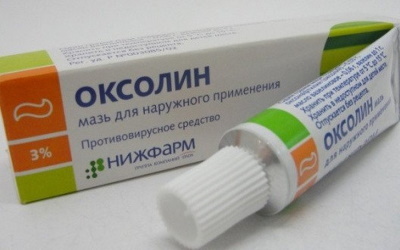 frequent airing;
frequent airing; - irrigation with water-salt solutions;
- lubricating the nasal cavity with oils and ointments (peach oil 1-2 drops or oxolinic ointment 0.5 cm in each nasal passage 3-4 times a day).
An irritating mucous procedure for lubricating the nasal passages with Lugol's solution has been proven effective to enhance local blood circulation and activate the glands.
From physiotherapeutic procedures, local warming up is shown:
- UHF;
- microwave;
- UV irradiation;
- helium-neon laser.
Additionally, insufflation (spraying of powdery substances) of fusafungin, rinofluimucil into the nose is possible twice a day, as well as instilling celandine juice, garlic, St. John's wort infusion or a weak solution octenisept.
Catarrhal
Obligatory points of treatment will be:
- humidification (inhaled air and mucous membranes by irrigation with saline solutions);
- local antiseptics (Hexasprey, 2 injections into each nostril 3 times a day);
- combinations of antibiotics (Izofra, 1 spray on inhalation into each nostril 4-6 times a day for 5-7 days).
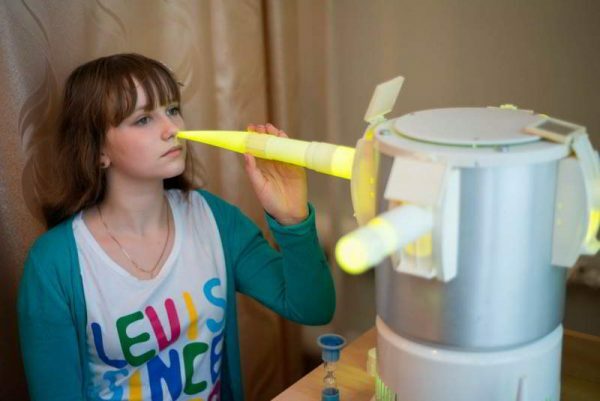
Nasal decongestants and physical therapy (UV and helium-neon laser, endonasal spraying rinofluimucil, instillation of a weak solution of octenisept) are connected to therapy as required and desired the patient.
Hypertrophic (hyperplastic)
Conservative treatment does not have sufficient effectiveness, therefore, after attempts to use sclerotherapy (moxibustion with silver nitrate, trichloroacetic or chromic acids, introduction into the inferior turbinate suspension of hydrocortisone (1 ml each, 2 times a week, a course of 8-10 procedures) and splenin (first 0.5 ml, and every other day already 1 ml)) and massage of the nasal mucosa, resort to surgical correction methods (removal of excessively overgrown tissues, impact on blood vessels or movement of the nasal concha outwards).
Vasomotor
A comprehensive approach to treatment includes:
- use of humidifiers-air purifiers in residential premises;
- rinsing the nose with saline solutions;
- lifestyle change;
- adherence to dietary recommendations;
- carrying out restorative procedures;
- getting regular physical activity;
- physiotherapy (laser and UV irradiation, endonasal electrophoresis of 0.5-0.25% zinc sulfate solution or 2% calcium chloride solution);
- local decongestants and antibacterial drugs (according to indications) or their combinations (for example, Polydex: 1 injection into each nasal passage while inhaling 3-5 times a day, 5-10 days).
Allergic
The basis of therapy is to minimize (until completely excluded) contact with the allergen, antihistamines of general and local action (for example, Erius inside, 1 tablet 1 time per day for 7 days and Tizin Alerji 0.25%, 2 drops in each nasal passage 2 times a day (up to a maximum of 4 times) until disappearance symptoms).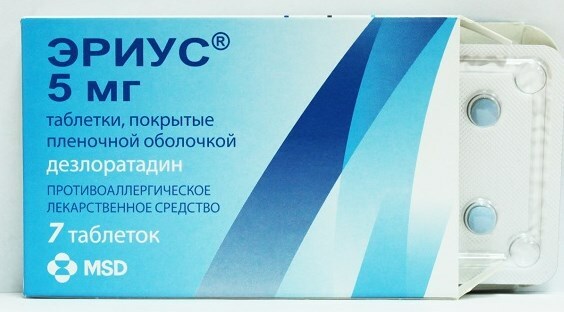 With profuse mucus or complete nasal congestion, local decongestants are used (Xylometazoline, Phenylephrine or others, 1 injection into each nostril, reapply not earlier, than in 4-6 hours)
With profuse mucus or complete nasal congestion, local decongestants are used (Xylometazoline, Phenylephrine or others, 1 injection into each nostril, reapply not earlier, than in 4-6 hours)
What is the danger of a lingering rhinitis, the consequences in the absence of treatment
The lack of treatment or its improper implementation in almost 100% of cases makes the patient face a significant deterioration in the quality of life due to the persisting obstruction of the nasal breathing, which leads to such painful conditions as hypoxia of organs and tissues, which leads to sleep disturbances, frequent migraine headaches, loss of memory and attention, general asthenization.
As world statistics show, most adults cannot cope with chronic rhinitis on their own, but precious time for sparing treatment is missed and the doctor has to deal with already complicated forms of diseases, which rarely can be cured without consequences.
Rhinitis video
Rhinitis symptoms and treatment:



